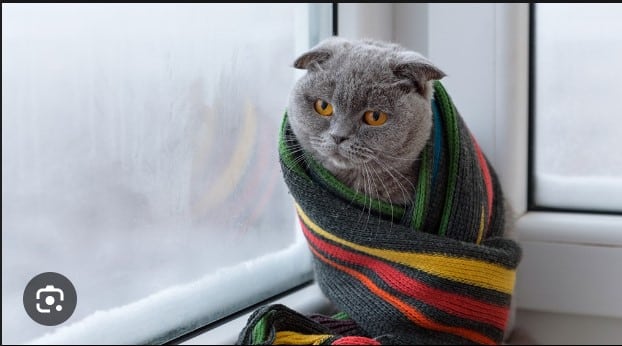Have you ever wondered whether your furry feline friend could feel the chill of winter? Or the cool breeze of an air-conditioned room? In this comprehensive article, we provide answers to the intriguing question: Can cats get cold? This article covers various aspects of cat’s physiology such as What to do when your cat has a cold. As well as behavioral and physical indicators, shedding light on how these marvelous creatures respond to temperature changes. From Understanding Feline Temperature Regulation to recognizing signs of Cold in Cats, we unravel the complex nature surrounding cat temperature.
Cats, like humans and other mammals, possess fascinating mechanisms for regulating body temperature. Understanding the signs of cold stress in cats is essential for providing prompt care and ensuring their well-being. Additionally, factors such as age, breed, health status, and environmental conditions play significant roles in determining a cat’s sensitivity to cold. Whether you’re a seasoned cat owner or considering adopting one, this article aims to provide valuable insights.
See also: What Cat Breed is Best to Gift Someone

Understanding Feline Temperature Regulation
Cats have their own unique ways of regulating body temperature. They can change how fast their bodies regulate temperature depending on how hot or cold it is around them. When exposed to colder environments, cats can increase their metabolic activity to generate heat and maintain core body temperature. This metabolic flexibility allows them to conserve energy and sustain warmth during chilly conditions, ensuring their survival in diverse habitats.
However, metabolic regulation alone does not account for cats’ resilience in the face of cold weather. Although cats are equipped with fur, they are still susceptible to feeling cold under certain conditions. Yet, it’s essential to understand that individual cats may have varying tolerance levels to cold temperatures. Behavioral adaptations also play a crucial role in helping cats navigate temperature fluctuations. Indoor cats, for instance, may seek out warm spots in the house. Spots such as sunny windowsills or cozy blankets, to bask in the heat and conserve energy. Outdoor cats, on the other hand, may utilize more active strategies. Such as finding sheltered areas or curling up in protected nooks to shield themselves from the cold.
Furthermore, cats exhibit a range of thermoregulatory behaviors that reflect their ability to adapt to changing environmental conditions. They may engage in self-grooming to distribute oils that help insulate their fur, or they may adjust their posture to minimize heat loss by curling into a compact ball. Additionally, cats are known to seek out the warmth of other animals or humans. Thus, demonstrating their social and practical approach to staying warm in cold climates.
See also: Melatonin for Cats
Interestingly, certain cat breeds have evolved specialized traits that enhance their tolerance to cold temperatures. Breeds like the Siberian Cats have thick, water-resistant fur. They’re built for cold climates and may enjoy playing in the snow.

Recognizing Signs of Cold in Cats
As responsible pet owners, it’s essential to be vigilant and attentive to our cats’ well-being. Especially during colder seasons or in environments with fluctuating temperatures. Cats can still experience discomfort and stress when exposed to prolonged cold conditions. Despite their natural adaptations to cope with cold weather Recognizing the signs of cold stress is crucial for providing timely care. It is also important in ensuring our feline friends remain healthy and comfortable.
One of the most common indicators of cold stress in cats is shivering. Like humans, cats may shiver when they’re feeling cold to generate heat and maintain their body temperature. Observing your cat for signs of shivering can signal that they’re feeling the cold and may need additional warmth or shelter.
Lethargy is another telltale sign that your cat may be experiencing cold stress. Cats are typically active and energetic animals. A sudden decrease in activity level or reluctance to engage in play could indicate that they’re feeling unwell due to the cold. Pay attention to changes in your cat’s behavior. Changes such as spending more time sleeping or seeking out warm spots in the house.
See also: Can Cats Eat Coconut?
In addition to physical symptoms, cats may also exhibit changes in their behavior when they’re feeling cold. Some cats may become more vocal, meowing or crying for attention, while others may become more withdrawn or seek solitude. These behavioral changes can be subtle, so it’s essential to observe your cat closely and notice any deviations from their normal patterns of behavior.

Behavioral and Physical Indicators
Seeking warmth excessively is another common behavior seen in cats experiencing cold stress. You may notice your cat gravitating towards heat sources like radiators, heaters, or even sitting close to a fireplace. Seeking warmth is a natural response to feeling cold. However, excessive or prolonged exposure to heat sources can pose risks, such as burns or dehydration. Providing safe, alternative sources of warmth can help alleviate your cat’s discomfort without compromising their safety.
Changes in appetite or eating habits can also indicate that your cat is feeling cold or unwell. Some cats may eat less when they’re feeling cold, while others may seek out warm, high-calorie foods to help maintain their energy levels. Monitoring your cat’s eating habits and ensuring they have access to a balanced diet can help support their overall health and well-being during colder months.
In conclusion, recognizing the signs of cold stress in cats is essential for providing prompt care and ensuring their comfort and well-being. By being attentive to changes in behavior, monitoring for physical symptoms like shivering or lethargy, and providing appropriate warmth and shelter, pet owners can help their feline companions stay healthy and happy, even in chilly weather. If you notice any signs of cold stress or if you’re concerned about your cat’s well-being, don’t hesitate to consult with your veterinarian for further guidance and support.
See also: What Pet to Choose between Cat and Dog: See Reasons and Comparison.

Responding to Signs of Discomfort
Recognizing signs of discomfort in your cat is crucial for ensuring their well-being. Especially during colder weather when they may be more susceptible to cold-related stress. It’s essential to respond promptly to address your cat’s needs. Especially if you notice any signs of cold stress, such as shivering, lethargy, or seeking warmth excessively.
One of the first steps in seeking prompt care for your cat is to provide immediate warmth and comfort. Move your cat to a warmer area of the house, away from cold drafts or direct airflow. Also, wrap them in a warm blanket or towel to help raise their body temperature. Furthermore, offer a cozy spot to rest and providing access to supplemental heat sources. Spots such as heated beds or warm water bottles, can also help alleviate discomfort.
Additionally, closely monitor your cat for any changes in behavior or symptoms that may indicate underlying health issues. If your cat’s condition doesn’t improve, seek veterinary help. Watch for symptoms of discomfort, such as trouble breathing. Your veterinarian can perform a thorough examination. As well as diagnose any underlying medical conditions and recommend appropriate treatment to help your cat recover.
See also: Can I Gift Someone a Pet like Dog or Cat?
Taking proactive measures to address your cat’s comfort and well-being is essential for ensuring their health and happiness, especially during colder weather when they may be more vulnerable to cold-related stress. By responding promptly to signs of discomfort and seeking veterinary care when needed, you can help your cat stay safe, healthy, and comfortable throughout the year.

What to Do When Your Cat Has a Cold
When your cat shows cold symptoms, act promptly. Provide comfort and support for their recovery. Firstly, ensure your cat has a warm and comfortable environment to rest in, free from rats or cold air. Provide soft bedding and consider placing a warm towel or heating pad in their sleeping area. This would help ease congestion and promote relaxation.
Next, offer plenty of fresh water and ensure your cat stays hydrated throughout their illness. Cold symptoms can lead to dehydration. So, it’s crucial to encourage your cat to drink by providing clean water in a shallow dish. To attract them, you can also utilize a pet fountain. Furthermore, try offering wet food or broth to increase their fluid intake and provide additional comfort.
Additionally, monitor your cat closely for any changes in their condition and consult with your veterinarian if symptoms persist or worsen. While most colds in cats are mild and resolved on their own with supportive care, some cases may require veterinary intervention. Especially if your cat develops complications or if their symptoms persist for an extended period. Your veterinarian can provide personalized advice and treatment options to help alleviate your cat’s symptoms. They can also promote a speedy recovery, ensuring they return to their playful and happy selves as soon as possible.
See also: How to Know When a Cat is Pregnant: Symptoms Of Early Pregnancy in Cats

Conclusion
In conclusion, the question “Can cats get cold?” reveals a complex feature of the physiology and behavior of cats. While cats possess natural adaptations to cope with cold weather, they are not immune to temperature sensitivity. Consequently, cat owners play a vital role in ensuring their pets’ comfort and well-being. Especially during colder seasons or in indoor environments with fluctuating temperatures. By understanding the signs of cold stress, implementing preventive measures, and providing attentive care, cat owners can nurture a warm and cozy environment for their beloved companions. Whether it’s a chilly winter day or a cool evening indoors, let’s strive to keep our feline friends happy, healthy, and purring with contentment.
See also: https://www.aspcapetinsurance.com/resources/cat-winter-care/

